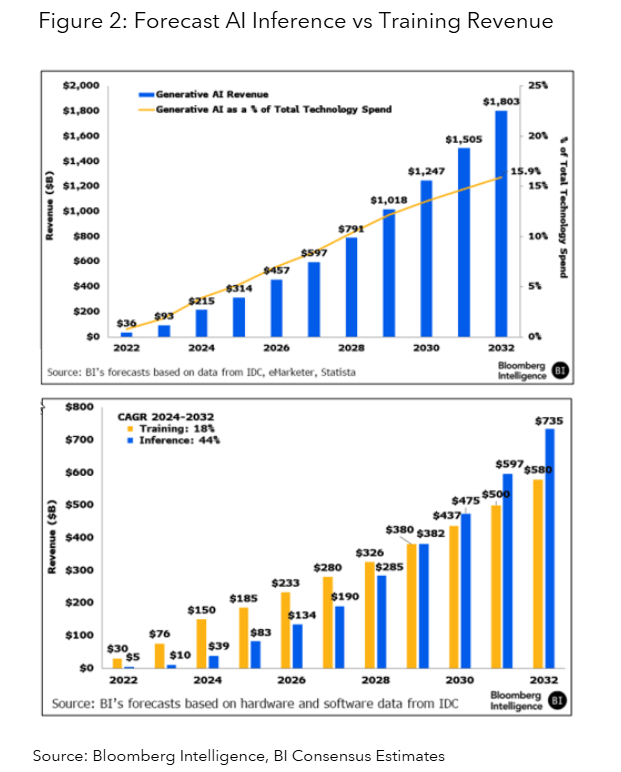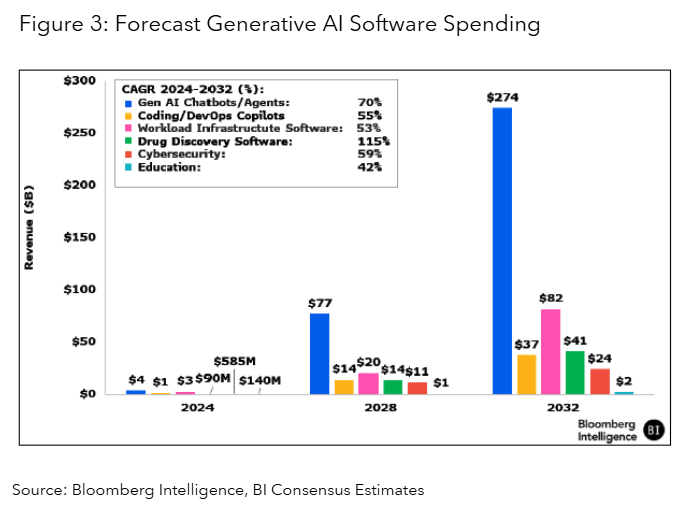ARTICLE
Inside AI’s rapid expansion: What investors need to know

Bloomberg Professional Services
How is artificial intelligence changing markets and investment strategy? This article looks at how AI adoption across hardware, software, and enterprise services is driving structural economic change, influencing portfolio construction, and redefining market leadership as inference, intelligent agents, and data infrastructure become central to the next phase of digital growth.
This article was written by Mike Pruzinsky, Equity Index Product Manager at Bloomberg Index Services Limited (BISL).
Welcome to part 1 of our 3-part blog series looking at how artificial intelligence (AI) is reshaping markets and how Bloomberg Indices can reflect this transformation in market structure and sector dynamics.
PRODUCT MENTIONS
What is the economic impact of AI?
In recent years, AI has moved from the edges of technology into the center of economic activity. What began with chatbots, and copilots is now powering hardware, cloud platforms, advertising, gaming, and enterprise services.
The reach of AI is expanding across healthcare, retail, and financial services. It is improving productivity, providing sharper insights, and reshaping long-standing business models. Bloomberg Intelligence projects that generative AI alone could generate $1.8 trillion dollars in annual revenue by 2032, representing up to 16 percent of global technology spending.

The projections in Figure 1 focus on future revenue. At the same time, they signal a broader change as AI becomes part of everyday operations and consumer behavior. This shift is transforming how the technology creates and distributes value. With adoption increasing, the debate is no longer about whether AI will find practical applications, rather the discussion now is understanding how AI-related themes may influence portfolio construction and long-term sector exposure.
The rise of inference and intelligent agents
AI is currently defined by acceleration. The newest generation of reasoning models can interpret, analyze, and generate content across text, images, audio, and video. These capabilities allow them to handle more complex tasks, moving beyond simple prompt-and-response interactions toward real problem solving and decision making.

One of the most important developments is the shift from training to inference. Training large models once dominated investor attention, because of the massive computing power required. Inference, which refers to the application of trained models in real-world settings, has become a focal point in AI commercialization discussions. Analysts had expected training to remain dominant for years, yet demand for inference has already surpassed expectations. This shift has drawn increased attention, as inference is associated with recurring use cases that may support a growing role in the evolving commercial landscape of AI.
At the same time, AI agents are moving from experimental tools to essential components of everyday business and consumer life. These digital workers are now being embedded into core processes, from reviewing contracts and managing customer service to personalizing shopping experiences and assisting with software development. Bloomberg Intelligence projects that AI agents could support a market worth more than $270 billion dollars by 2032, highlighting their potential to reshape both enterprise operations and consumer interactions.

How is AI reshaping the hardware market?
The AI boom is not only about software. The physical infrastructure that enables AI is being rebuilt at scale. Semiconductors, hyperscaler capital expenditures, robotics, and IT services are all evolving to support the new demands. AI workloads already account for more than 20% of global server revenue, and that share is projected to rise to 40% in the coming years.
The explanation is straightforward. Training workloads are intensive but occur in quick intervals, while inference workloads run continuously in real-world applications. This trend reflects a shift to more consistent infrastructure demand to account for real-world AI applications that require continuous processing power. Thus, these AI workloads may contribute to longer-term demand for hardware infrastructure, with growth supported by structural demand potentially reducing the cyclical volatility that has historically defined the sector.
How is generative AI transforming workflows and advertising?
Copilots, coding assistants, and generative creative platforms are changing how people work. They streamline processes, create entirely new product categories, and open the door to subscription models and integration opportunities. Companies with proprietary data and scale are building competitive advantages that could be difficult for challengers to match.

As can be seen in Figure 4, AI is already shifting digital experiences for many consumers. Personalized recommendations, dynamic content generation, and more interactive creative tools are becoming standard. For companies that deliver scalable, AI-driven targeting, they are increasingly seen as well-positioned to benefit from a growing demand for these personalized experiences.
How the AI boom can be tracked through Bloomberg Indices
As AI adoption grows, market participants are increasingly turning to tools and data that can quantify its influence. Bloomberg provides these tools through its indices which offer thematic exposure. The Bloomberg Artificial Intelligence Total Return Index (BAIT Index) tracks a basket of global companies selected for their involvement in AI adoption across hardware, software, and services.
Meanwhile, the Bloomberg AI Value Chain Index (BAIVT Index) takes a more structured approach, by tracking companies aligned to the backbone of the AI ecosystem, from semiconductor designers and cloud hyperscalers to application developers and enterprise adopters.

Bloomberg’s AI indices, including BAIT and BAIVT, are practical tools to track and measure this transformation. They offer systematic exposure to companies that are shaping and benefiting from the AI economy. As Bloomberg Intelligence has noted, the speed and scale of AI’s adoption across industries has been both rapid and far-reaching.
Mapping AI’s evolving market impact
This article is the first of a three-part series exploring AI’s investment landscape.
In part 2, focusing on mapping the AI value chain, we will explain how chips, cloud infrastructure, models, and applications create value, and how Bloomberg indices measure that opportunity.
In part 3, looking at AI Thematic Indices, we will explore how the rules-based approach identifies companies with material involvement in AI development or deployment, supported by the Bloomberg Intelligence analyst team.
Together, these articles aim to provide investors with a complete framework for understanding how AI is transforming markets and how Bloomberg Indices can help measure and capture exposure to the theme.
To learn more about Bloomberg Indices, click here.
Bloomberg Indices Disclaimer: The data and other information included in this publication is for illustrative purposes only, available “as is”, non-binding and constitutes the provision of factual information, rather than financial product advice. BLOOMBERG and BLOOMBERG INDICES (the “Indices”) are trademarks or service marks of Bloomberg Finance L.P. (“BFLP”). BFLP and its affiliates, including BISL, the administrator of the Indices, or their licensors own all proprietary rights in the Indices. Bloomberg L.P. (“BLP”) or one of its subsidiaries provides BFLP, BISL and its subsidiaries with global marketing and operational support and service. Certain features, functions, products and services are available only to sophisticated investors and only where permitted. Bloomberg (as defined below) does not approve or endorse these materials or guarantee the accuracy or completeness of any information herein, nor does Bloomberg make any warranty, express or implied, as to the results to be obtained therefrom, and, to the maximum extent allowed by law, Bloomberg shall not have any liability or responsibility for injury or damages arising in connection therewith. Nothing in the Services or Indices shall constitute or be construed as an offering of financial instruments by Bloomberg, or as investment advice or investment recommendations (i.e., recommendations as to whether or not to “buy”, “sell”, “hold”, or to enter or not to enter into any other transaction involving any specific interest or interests) by Bloomberg. Information available via the Index should not be considered as information sufficient upon which to base an investment decision. All information provided by the Index or in this publication is impersonal and not tailored to the needs of any person, entity or group of persons. Absence of any trademark or service mark from this list does not waive Bloomberg’s intellectual property rights in that name, mark or logo. For the purposes of this publication, Bloomberg includes BLP, BFLP, BISL and/or their affiliates.
BISL is registered in England and Wales under registered number 08934023 and has its registered office at 3 Queen Victoria Street, London, England, EC4N 4TQ. BISL is authorized and regulated by the Financial Conduct Authority as a benchmark administrator. © 2025 Bloomberg. All rights reserved.
Bloomberg Intelligence Disclaimer: The data included in these materials are for illustrative purposes only. The BLOOMBERG TERMINAL service and Bloomberg data products (the “Services”) are owned and distributed by Bloomberg Finance L.P. (“BFLP”) except (i) in Argentina, Australia and certain jurisdictions in the Pacific islands, Bermuda, China, India, Japan, Korea and New Zealand, where Bloomberg L.P. and its subsidiaries (“BLP”) distribute these products, and (ii) in Singapore and the jurisdictions serviced by Bloomberg’s Singapore office, where a subsidiary of BFLP distributes these products. BLP provides BFLP and its subsidiaries with global marketing and operational support and service. Certain features, functions, products and services are available only to sophisticated investors and only where permitted. BFLP, BLP and their affiliates do not guarantee the accuracy of prices or other information in the Services. Nothing in the Services shall constitute or be construed as an offering of financial instruments by BFLP, BLP or their affiliates, or as investment advice or recommendations by BFLP, BLP or their affiliates of an investment strategy or whether or not to “buy,” “sell,” or “hold” an investment. Information available via the Services should not be considered as information sufficient upon which to base an investment decision. The following are trademarks and service marks of BFLP, a Delaware limited partnership, or its subsidiaries: BLOOMBERG, BLOOMBERG ANYWHERE, BLOOMBERG MARKETS, BLOOMBERG NEWS, BLOOMBERG PROFESSIONAL, BLOOMBERG TERMINAL and BLOOMBERG.COM. Absence of any trademark or service mark from this list does not waive Bloomberg’s intellectual property rights in that name, mark or logo. All rights reserved. © 2025 Bloomberg.
Bloomberg Intelligence is a service provided by Bloomberg Finance L.P. and its affiliates. (“Bloomberg”). Bloomberg is not an officially recognized credit rating agency in any jurisdiction, and customers should not use or rely on Bloomberg Intelligence to comply with applicable laws or regulations that prescribe the use of ratings issued by accredited or otherwise recognized credit rating agencies. Bloomberg Intelligence Credit and Company research may not be available in certain jurisdictions.
Bloomberg Intelligence shall not constitute, nor be construed as, investment advice or investment recommendations (i.e., recommendations as to whether or not to “buy,” “sell,” “hold,” or to enter or not to enter into any other transaction involving any specific interest) or a recommendation as to an investment or other strategy. No aspect of the Bloomberg Intelligence function is based on the consideration of a customer’s individual circumstances. Bloomberg Intelligence should not be considered as information sufficient upon which to base an investment decision. Customers should determine on their own whether they agree with Bloomberg Intelligence. Bloomberg Intelligence should not be construed as tax or accounting advice or as a service designed to facilitate any Bloomberg Intelligence customer’s compliance with its tax, accounting, or other legal obligations. Bloomberg believes that the information it uses in Bloomberg Intelligence comes from reliable sources, but does not guarantee the accuracy of information contained in Bloomberg Intelligence. Employees involved in Bloomberg Intelligence may hold positions in the securities analyzed or discussed on Bloomberg Intelligence.
Bloomberg makes no claims or representations, or provides any assurances, about the sustainability characteristics, profile or data points of any underlying issuers, products or services, and users should make their own determination on such issues.